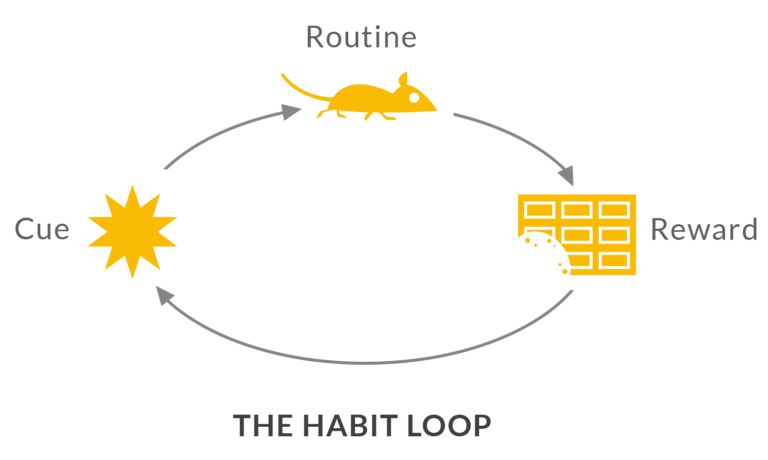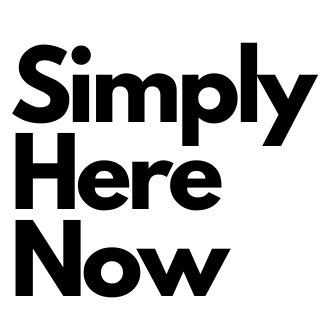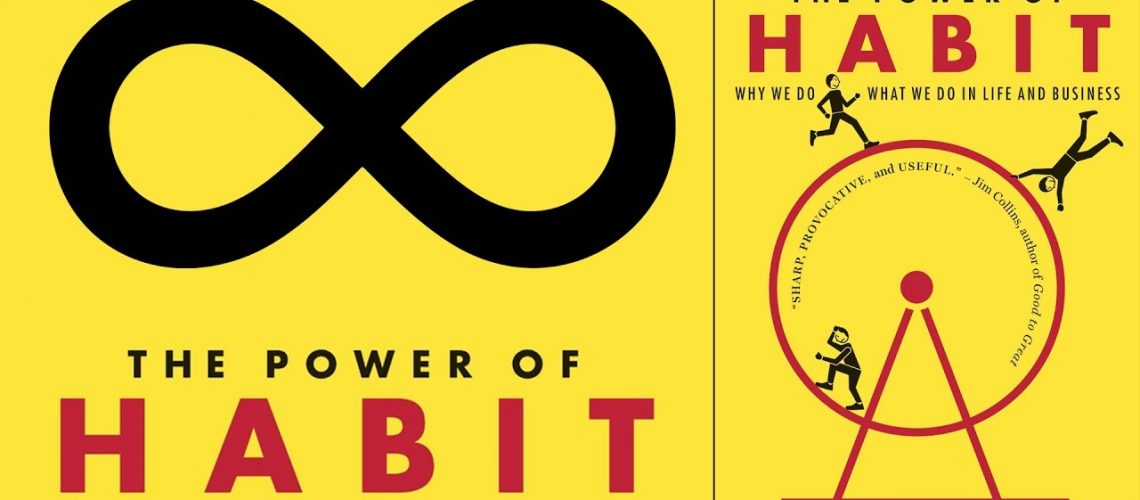In the following videos you'll learn the golden rules of habits and key takeaways from the book "The Power of Habit."
Charles Duhigg explains why habits exist and how they can be changed.
The key to exercising regularly, losing weight, being more productive, and achieving success is understanding how habits work.
As Duhigg shows, by harnessing this new science, we can transform our businesses, our communities, and our lives.
Key Takeaways
"There's nothing you can't do if you get the habits right."
If you’ve ever had a craving that you couldn’t resist, like the urge to eat a cupcake sitting gracefully on your kitchen countertop. You know what I mean.
Stopping a bad habit with sheer willpower rarely works. The only way to reliably calm cravings and banish bad habits is to leverage the golden rule of habit change.
The golden rule of habit change says if you want to change a bad habit, keep the cue from your bad habit–what triggers your cravings and the reward of your bad habit, the sensation you crave, but insert a new routine.
Whether you want to stop wasting hours mindlessly checking your phone or snacking on food that makes you feel like crap, you can use the golden rule of habit change to gain power over your bad habits by following three steps.
Three Steps to Habit Change
1. Rethink the Reward
When a smoker craves a cigarette, they crave the nicotine in the cigarette. Right?
Well if that were true, smokers who use a nicotine patch or chew nicotine gum when they crave a smoke should be able to stop smoking, however less than 10 percent of smokers who use nicotine patches or gum quit smoking.
What the smokers actually crave is less obvious.
- Some smokers crave a cigarette because their brains have associated smoking with going outside and socializing with other smokers.
- Other smokers crave cigarettes because the act of smoking relieves boredom and provides a temporary escape from their anxiety.
In either case these smokers don’t need a cigarette to experience the reward they’re actually craving.
Just as smokers don’t need a cigarette to satisfy their cigarette craving, we don’t need a cupcake to satisfy our cupcake craving or we don’t need to check our phone to satisfy our phone craving.
If that’s the case, then slowly sipping a cup of tea or getting down and doing push-ups will provide the stimulation we desire.
Or maybe what we really want is to relieve stress and get our minds off work. If it’s the mental break we crave then going for a walk and listening to music will do.
University of Virginia Study
The room was empty except for a device that allowed the participants to give themselves a mildly painful shock.
In their conclusion, the researchers said it best: Most people seem to prefer to be doing something rather than nothing, even if that something is negative.
2. Test New Routines
When author Charles Duhigg was writing this book, he developed a daily cookie craving. As a result, Duhigg was gaining weight and receiving comments from his wife about his ever-expanding waistline.
First he needed to isolate the cue that triggered his cookie craving.
For the next week he answered four questions every time he experienced a cookie craving:
- Where am I?
- What time is it?
- What’s my emotional state? (Stressed, anxious, bored)
- What am I doing? That is what action is preceding my craving
After a week of observing what led to his cookie craving, he was able to see a pattern and isolate the cue that triggered his bad habit. At roughly 3:30 p.m, every day while in the office, he started craving a cookie.
Over the course of the next few days, he set an alarm for 3:30 pm and executed a non cookie eating routine each day.
Then 15 minutes later he would take note of how he was feeling and if his craving had subsided.
- On the first day he walked around the block and then went back to his desk without eating anything. That wasn’t very effective.
- The next day he bought an apple at the cafeteria, ate it, then went back to his desk. That also didn’t satisfy his craving.
- The next day he ordered a cup of coffee and went back to work. That slightly worked.
- But the following day he went to a friend’s office and gossiped for a few minutes and then went back to his desk. That seemed to work.
"Through experimentation, I had learned that it wasn't really the cookie I craved. Rather, it was a moment of Distraction and the opportunity to Socialize."
After a few weeks of setting an alarm at 3:30 pm and talking with a friend, he found that he no longer craved a cookie and he says at about 3:30 every day I started absentmindedly standing up, looking around the newsroom for someone to talk to, spending 10 minutes gossiping about the news and then going back to my desk. It occurred every day without me thinking about it. It had become a habit.
The first few weeks of replacing a bad routine with a better, healthier routine will involve some slip ups and require a bit of willpower, but luckily there’s a hack for that–script your new routine.
3. Script Your New Routine
In the study, half the patients were asked to write out where and when they plan to go for a walk each day.
- For example at 2 pm I will go for a walk around my neighborhood, but the other half simply set the intention of walking more, but did not write down a specific walking plan each day.
When the psychologist leading the study visited the patients three months later, she found that the patients who had detailed walking plans walked almost twice as fast as the ones who had not and the patients with detailed walking plans had started getting in and out of their chairs unassisted almost three times faster.
The same principle will apply to changing any bad habit.
By simply writing out what you will do when the cue for your bad habit is present, you’ll dramatically increase the odds of executing your new routine.
Angela Duckworth, the author of Grit, and a willpower researcher at UPenn says…
"Sometimes it looks like people with great self-control aren't working hard, but that's because they've made it automatic. Their willpower occurs without them having to think about it.
Conclusion
In the end, instead of using your willpower to suppress cravings and resist bad habits–Get curious and study your bad habit loop.
Get in the habit of asking yourself what is the exact cue that is triggering my bad habit? Then, what’s the real reward I seek?
Remember that just because you crave a cupcake doesn’t mean you need to eat a cupcake to satisfy your craving.
Then leverage the golden rule of habit change by experimenting with different routines that can deliver a similar reward and satisfy your craving.
The goal is to get to the point where you can write down when I (write down your old cue) I will (write down your new routine) to experience your old reward.
Charles Duhigg TED Talk and Fight Mediocrity Video Summary
Key Takeaways
Habits aren’t destiny, even once they are rooted in our minds. We can choose our habits, once we know how.
Everything we know about habits, from neurologists studying amnesiacs and organizational experts remaking companies, is that any of them can be changed, if you understand how they function.
40-45% of the daily decisions we make on a daily basis aren’t actually decisions, but habits.
Every habit has cues and rewards and it’s the cue and the reward which influence how habits function.
Willpower seems to be the greatest correlate with future success. It seems to prepare people for life.
How do you teach willpower? By choosing an action ahead of time, through habit.
How do you change a habit? By premeditating cues and rewards.
Simply understanding how habits work make them much easier to control. By learning to observe the cues and rewards, we can change the routines.
The Habit Loop
The Habit loop is compromised of a routine, which is preceded by a cue, and followed by a reward.
This is how you achieve consistency. You keep tweaking the cues and rewards instead of beating yourself up for lacking discipline and having low willpower.
1. Cue automatic trigger for a behavior to start.
2. Routine Physical, mental, or emotional behavior that follows the cue.
3. Reward A positive stimulus that tells your brain that the routine works well, and is worth remembering.

1. Affirmations need to stay positive, need to stay on things you will do as opposed to what you won’t do. i.e. I will go for a run, I am going to eat healthily.
2. If Then Statements if I create this habit, if I go on a run today: if… THEN I will have a healthier body
Habits have cues and rewards.
If you decide ahead of time. If you engage in this mindfulness in your life where you are aware of what’s driving these nearly subconscious behaviors where your brain shuts off.
If you indulge yourself to pay attention to the things that otherwise happen in the periphery of our consciousness. We know from study after study you have the ability to change any habit in your life.
Most of the choices we make each day may feel like the products of well-considered decision making, but they're not. They're habits.


